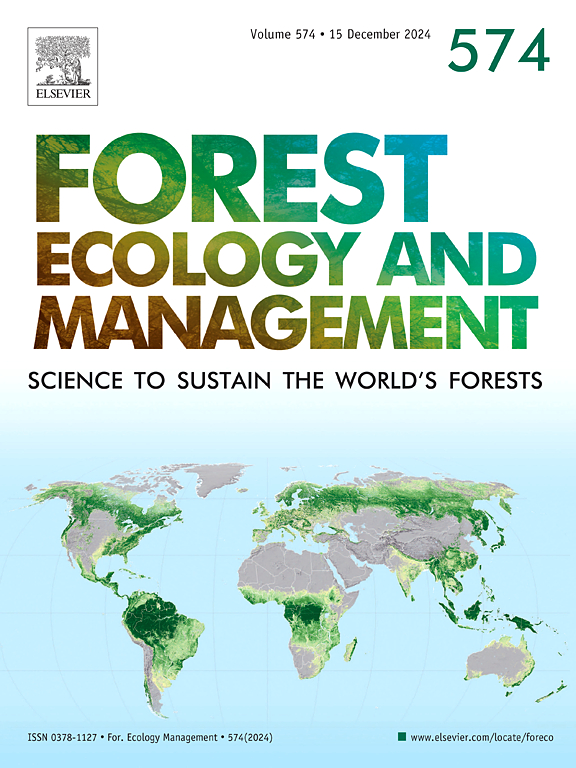森林作业的机械化推动了植物群落的长期变化
IF 3.7
2区 农林科学
Q1 FORESTRY
引用次数: 0
摘要
利用一个永久的样地网络,我们重新调查了法国东北部一片阔叶林的植被,追踪了1990年至2022年间气候变化、富营养化和森林管理的影响。为了更好地检测机械化对植物群落的影响,我们基于微地形(滑径和车轮轨迹)建立了子样地,并在这些子样地中分别记录了物种。然后,我们测试了物种频率的变化,并使用排序来分析群落组成的变化。利用样地和子样地的物种指标值,以及对应分析轴1上的样地变化作为林分特征、车辆干扰、冠层开口、动物压力、风暴影响和所有权的函数进行回归分析,评估了变化。结果表明:非林种、喜湿种、喜轮径和滑径的种类有所增加;林业车辆造成的压实与土壤水分和氮的指标值增加有关。对对应分析的子样面调查的投影证实了车轮痕迹和滑痕是观测到的植被移动的主要驱动因素。这些,以及冠层开度,在回归分析中是显著的。虽然我们观察到植物群落的热干燥化(每个生物适应度+0.27 °C)落后于记录的温度升高(+1.5 °C),但这只是整体植被变化的一个次要原因。因此,机械化正在成为整个森林范围内植被变化的驱动因素。随着在温带落叶林中使用采集机的增加,林业作业的规划应更好地考虑到这些对植被的影响。本文章由计算机程序翻译,如有差异,请以英文原文为准。
Mechanisation of forest operations drives long-term changes in plant communities
Using a permanent network of plots, we resurveyed vegetation in a broadleaved forest of northeastern France, tracking the effects of climate change, eutrophication and forest management between 1990 and 2022. To better detect the impact of mechanisation on plant communities, we established subplots based on microtopography (skid trails and wheel tracks) and recorded species separately in these subplots. We then tested changes in species’ frequency and used ordination to analyse changes in communities’ composition. Shifts were assessed using species’ indicator values in plots and subplots, as well as regression analysis of plot shifts on axis 1 of the correspondence analysis as a function of stand characteristics, vehicle disturbances, canopy openings, game pressure, storm impact and ownership. Results showed a progress of non-forest species, hygrophilous species and species preferring wheel tracks and skid trails. Compaction from forestry vehicles was associated with an increase in indicator values for soil moisture and nitrogen. The projection of subplot surveys onto the correspondence analysis confirmed wheel tracks and skid trails as the main driver of observed vegetation shifts. These, as well as canopy openings, were significant in the regression analysis. Although we observed thermophilisation of plant communities (+0.27 °C per bioindication) which lagged behind recorded temperature increase (+1.5 °C), this was only a minor cause of overall vegetation changes. Mechanisation is therefore becoming a driver of vegetation changes at the scale of entire forests. As the use of harvesters in temperate deciduous forests increases, the planning of forestry operations should better account for these impacts on vegetation.
求助全文
通过发布文献求助,成功后即可免费获取论文全文。
去求助
来源期刊

Forest Ecology and Management
农林科学-林学
CiteScore
7.50
自引率
10.80%
发文量
665
审稿时长
39 days
期刊介绍:
Forest Ecology and Management publishes scientific articles linking forest ecology with forest management, focusing on the application of biological, ecological and social knowledge to the management and conservation of plantations and natural forests. The scope of the journal includes all forest ecosystems of the world.
A peer-review process ensures the quality and international interest of the manuscripts accepted for publication. The journal encourages communication between scientists in disparate fields who share a common interest in ecology and forest management, bridging the gap between research workers and forest managers.
We encourage submission of papers that will have the strongest interest and value to the Journal''s international readership. Some key features of papers with strong interest include:
1. Clear connections between the ecology and management of forests;
2. Novel ideas or approaches to important challenges in forest ecology and management;
3. Studies that address a population of interest beyond the scale of single research sites, Three key points in the design of forest experiments, Forest Ecology and Management 255 (2008) 2022-2023);
4. Review Articles on timely, important topics. Authors are welcome to contact one of the editors to discuss the suitability of a potential review manuscript.
The Journal encourages proposals for special issues examining important areas of forest ecology and management. Potential guest editors should contact any of the Editors to begin discussions about topics, potential papers, and other details.
 求助内容:
求助内容: 应助结果提醒方式:
应助结果提醒方式:


